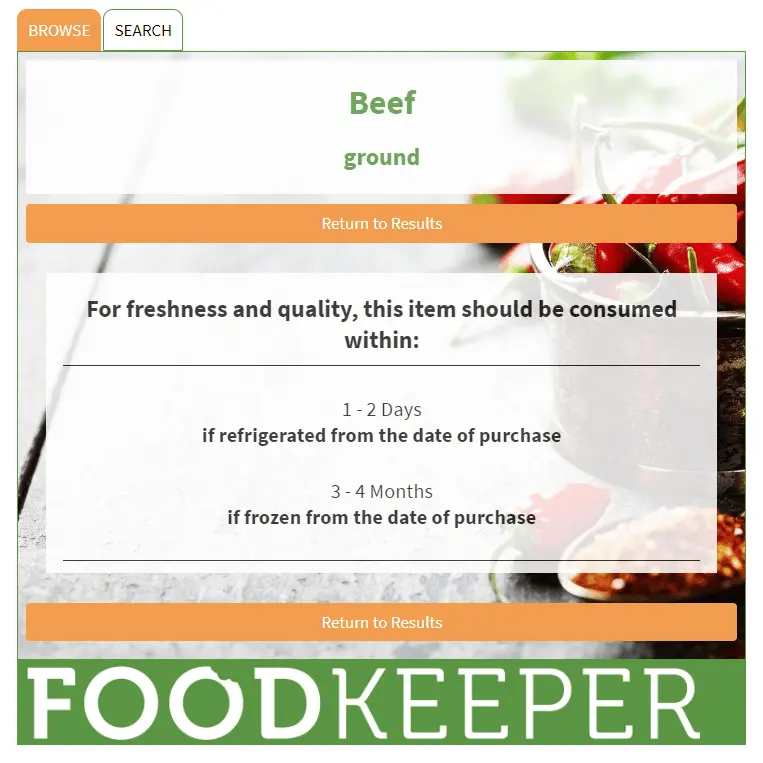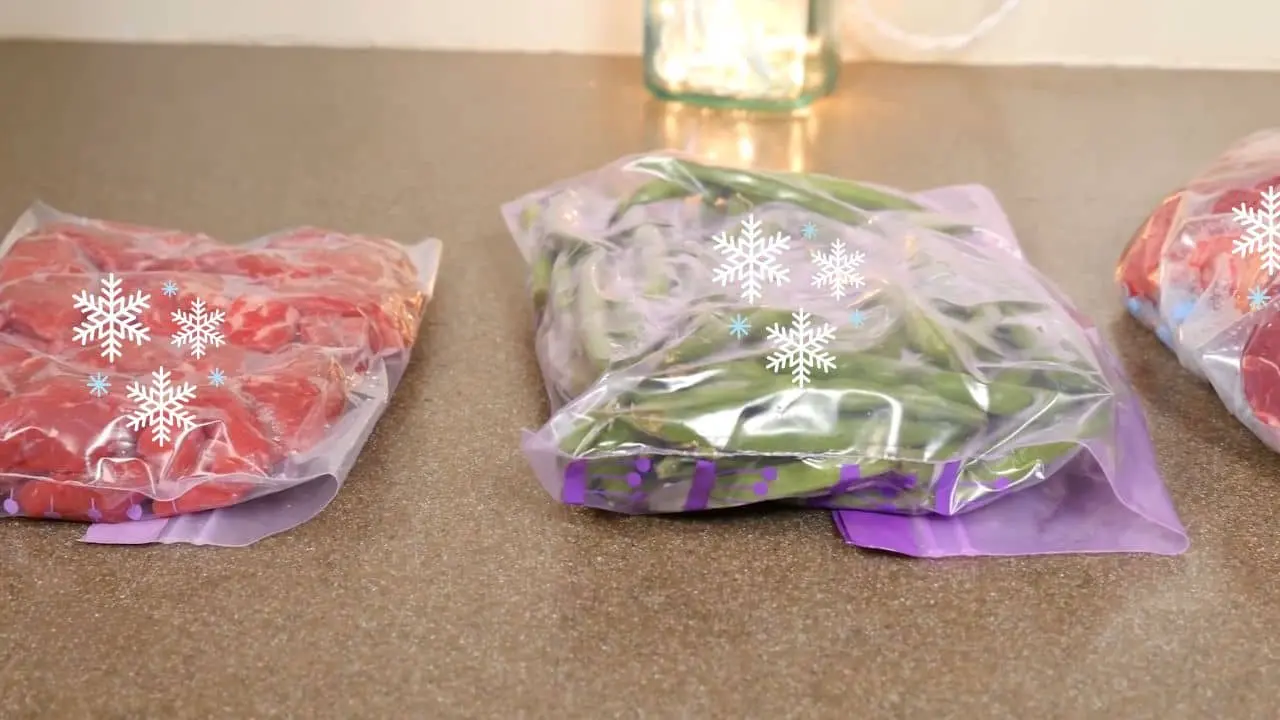Can You Use Storage Bags For Freezing? (6 Helpful Tips)
Freezing food is an essential task in many kitchens, and having the right materials can make a significant difference in preserving the quality and freshness of your food.
One of the most commonly used items for this purpose is freezer bags. But could you use storage bags when freezing your food?
Yes, you can use storage bags for freezing, but not all storage bags are suitable for this purpose. Some storage bags are designed specifically for freezer use, while others may not be able to withstand the low temperatures and prevent freezer burn.
I’m now going to go into more detail on the subject so that you can use the right bags to freeze all types of food.
RELATED:
- The 7 Best Materials for Freezing Containers (Including Tips)
- What Is the Difference Between Freezer Bags and Storage Bags?
- Can You Put Metal Containers in the Freezer? (Solved)
Optimizing Freezing: The Expert’s Guide to Using Storage Bags
Drawing from my extensive experience and meticulous research, I present to you a definitive guide on how to use storage bags for freezing to their utmost potential.
6 Essential tips for quality
#1 Always prioritize bags that are explicitly labeled as “freezer bags” or “freezer safe”. Their design is a cut above the rest, boasting a thicker material and a robust seal that ensures optimal freshness.
Brands like Glad Zipper Food Storage Freezer Bags, Ziploc Freezer Bags, and Hefty Slider Freezer Bags are top-tier choices in this category.
#2 It’s essential to sidestep bags that are noticeably thin or show any signs of wear and tear. Such bags are susceptible to leaks, which can jeopardize the food’s quality.
Moreover, it’s a cardinal rule to avoid bags not specifically designed for food storage, such as trash or sandwich bags. They can contain undesirable chemicals that shouldn’t mingle with your food.
Did you know?
Take a moment to smell the plastic bag up close. If you detect a pronounced odor, it’s indicative of subpar plastic quality. This tidbit isn’t just limited to bags; it’s a handy tip for assessing all plastic items.
#3 When filling your bags, always account for the expansion of food when frozen by leaving some space at the top. To safeguard the quality of your frozen items, make it a practice to expel as much air as possible before sealing. This step is pivotal in minimizing the dreaded freezer burn.
#4 Labeling isn’t just a nicety; it’s an essential practice. Marking the content and date ensures you maintain an efficient inventory and rotation system, which in turn helps in reducing waste. A simple permanent marker will serve you well in this task.

#5 For the best freezing results, lay the bags flat, ensuring they aren’t squashed by other items. This approach promotes quicker and more uniform freezing. If space allows, an initial freeze on a baking sheet can be beneficial before placing them for long-term storage.

#6 When it comes to thawing, precision is key. My recommendation is to either place the bags in the refrigerator overnight or submerge them in cold water. Methods like using hot water or microwaves for thawing can be counterproductive, leading to uneven thawing and potential bacterial growth.
Armed with these insights, you’re now poised to harness the full benefits of freezing with storage bags.
Freezer Storage Chart: Maximizing Food Quality
Ever wondered how long your foods maintain peak quality in the freezer? Here’s a straightforward chart to guide you.
Note: While frozen foods remain safe indefinitely, this chart focuses on optimal quality.
| Item | Months |
|---|---|
| Bacon and Sausage | 1 to 2 |
| Casseroles | 2 to 3 |
| Egg whites or egg substitutes | 12 |
| Frozen Dinners and Entrees | 3 to 4 |
| Gravy, meat or poultry | 2 to 3 |
| Ham, Hotdogs and Lunchmeats | 1 to 2 |
| Meat, uncooked roasts | 4 to 12 |
| Meat, uncooked steaks or chops | 4 to 12 |
| Meat, uncooked ground | 3 to 4 |
| Meat, cooked | 2 to 3 |
| Poultry, uncooked whole | 12 |
| Poultry, uncooked parts | 9 |
| Poultry, uncooked giblets | 3 to 4 |
| Poultry, cooked | 4 |
| Soups and Stews | 2 to 3 |
| Wild game, uncooked | 8 to 12 |
Potential drawbacks and risks
When using storage bags for freezing, there are some potential drawbacks and risks to be aware of. One of the most common issues is freezer burn, which occurs when air comes into contact with the food surface. This can lead to a loss of moisture and a change in texture, affecting the food’s quality and taste.
To minimize freezer burn, it’s essential to remove as much air as possible from the storage bags before sealing them.
Another concern when using storage bags for freezing is food safety. Freezing can help preserve your food and extend its shelf life while maintaining its nutritional value. However, it’s crucial to ensure proper handling and storage of frozen items.
According to the Cold Food Storage Chart, it’s essential to store foods at 0°F or below and adhere to recommended storage times for optimal safety.
In addition to food safety, proper food preservation plays a significant role in maintaining the quality of your frozen items. Storage bags may not always provide an airtight seal, which can allow odors from other items in the freezer to affect your stored food.
Double-bagging your items or using bags specifically designed for freezing can help minimize this issue.
Lastly, the freshness of your food should also be taken into consideration. While freezing can extend the shelf life of your food, it doesn’t stop the aging process entirely. Over time, the texture, taste, and appearance of your frozen food may change.

To ensure that your food remains at its peak quality and maintain its freshness, use the FoodKeeper app as a guide for optimal storage times.
Top picks for freezer bags
Freezing food, particularly fruits, demands the right kind of storage bags to ensure optimal freshness and quality. The ideal freezer bags should be versatile enough to hold different food sizes and provide an airtight seal, ensuring prolonged freshness.
A pivotal aspect of a top-notch freezer bag is its construction material. Bags crafted from premium polyethylene stand out for their stellar defense against freezer burn. Not only are these bags robust, but they also ward off potential leaks and punctures.
Size matters when selecting a freezer bag. It’s wise to have a collection of bags in assorted sizes to cater to your varied freezing requirements. For example, for those hefty fruits, a 2-gallon bag might be just the ticket. On the other hand, petite bags are perfect for diced fruits, veggies, or other bite-sized goodies.
Also, I can’t stress enough the importance of a hermetic seal. It’s what prevents food from drying out or adopting unpleasant flavors or aromas. To choose the best options, refer to the brands I mentioned at the beginning of my article.
And let’s not forget about labeling. Bags that come with pre-made labels or a dedicated space for jotting down with a marker are a boon. It’s a game-changer when you’re rummaging through a packed freezer hunting for a particular item.
For the freshest food storage:
- Prioritize bags crafted from top-tier polyethylene.
- Have an assortment of bag sizes at your disposal.
- Seek out bags with reliable airtight seals, like those with double or triple zippers.
- Bags with pre-made labels or writing spaces are a definite plus.
Conclusion
Freezing food using storage bags is a practical approach to both preserving and neatly organizing kitchen essentials. These bags, especially those made of polyethylene, are tailored to endure cold temperatures, safeguarding your food from ice crystals and ensuring prolonged freshness.
When packing, it’s crucial to leave room for the expansion of water, preventing potential messes from bursting bags. Using a vacuum sealer further enhances the quality of storage by minimizing air, thus reducing freezer burn.
Beyond just freezing, these bags can be repurposed for various kitchen tasks, such as prepping smoothie ingredients or storing baking essentials. When it’s time to use your stored items, proper thawing and reheating are vital for maintaining taste and texture.
In essence, storage bags are indispensable tools for an organized kitchen and optimal food preservation. By adhering to these guidelines, you can maximize your freezer’s efficiency, economize on food expenses, and ensure the longevity of perishables.
Happy freezing!
Note: I’m always eager to learn from others. If you have personal experiences or unique tips related to freezing with storage bags, please share your insights in the comments below. Your wisdom might just be the tip someone else needs!
Sources
- Food Safety and Inspection Service: Freezing and Food Safety
- University of Nebraska–lincoln: Freezer Bag Tips








I bought the hefty double zipper freezer bags. I always wipe the seal clean and get all air out and lie flat. After frozen we bring in the tray used that we froze on and our corn had leaked out after I went through all procedures of ensuring safety! Why would it leak? Any suggestions appreciated!
Sorry for the delayed response; I hadn’t received a notification of your comment.
Despite taking careful steps to ensure a proper seal, leakage can still occur due to several factors:
Manufacturing Defects: Even with meticulous sealing, some bags may have minor defects or inconsistencies that lead to leaks. A discussion on the Smoking Meat Forums highlighted similar experiences, noting that both Ziploc and Hefty resealable bags sometimes exhibited leakage issues.